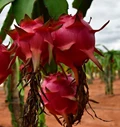
Around 4,000 farmers from Kutch's nine talukas demonstrated at native mamlatdar office demanding that Narmada water be made available for agricultural use.
Farmers believe they are forced to pick only one crop every year due to non- availability of irrigation water.
Farmers demonstrated under the banner of the Bhartiya Kisan Sangh. Narmada water is available for consumption in Kutch's Bhachau and Rapar. Radhu Ahir, the farmer leader of Anjar taluka, remarked, "We shall accept only one crop every year. We would take two to a few crops if we obtain Narmada water for irrigation. The federal government had promised to replenish our bodies with Narmada water across Kutch. If the promise is kept, the water will flow.
If the pledge is fulfilled, the district's water desk will improve, and we will get floor water just for irrigation."
Kutch's arid land is famous for its Kesar mango and dragon fruit, both of which require a lot of water. Farmers filed a memorandum to all mamlatdars indicating that because the floor water level has reached 500-700 ft., it has become difficult to obtain water for irrigation. Farmers also urged that they be supplied with sufficient amount of fertilizer.
The Kutch district is India's largest, covering 45,652 square kilometers. Agriculture and animal husbandry are the district's primary economic activities. Wheat, Bajra, Cotton, Castor, and Groundnut are the other major crops cultivated. Small and marginal farmers own around 72 percent of the land holdings, with an average holding size of 2 hectares.
As the monsoon continues to be irregular, there is a greater need for attention to water resource management. Farmers must be incentivized to preserve water by implementing appropriate planting patterns on their fields. Soil moisture security must be preserved in order to produce "more crop per drop."











